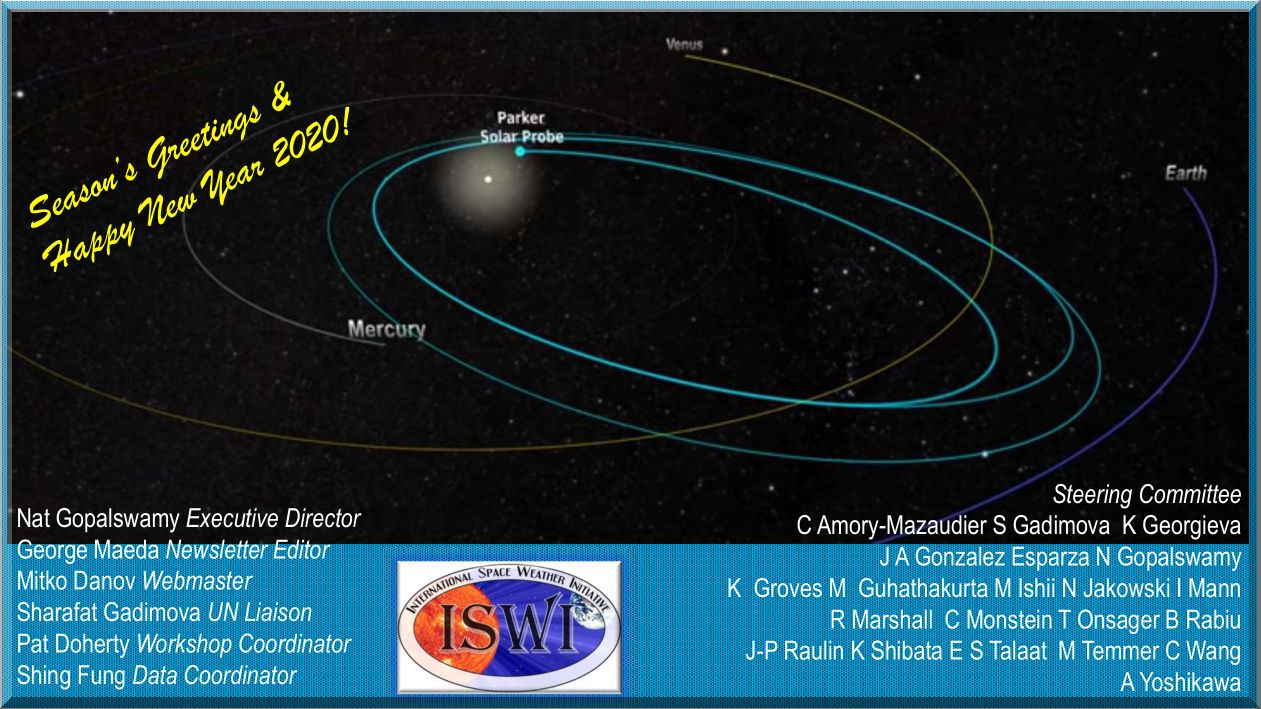ISWI Newsletter - Vol.11 No.17
30 December 2019
Dear ISWI Participant:
Thanks to all who contributed material in 2019.
George Maeda
Editor of ISWI Newsletter
CONTENTS OF THIS ISSUE
[1] Season's greetings from the ISWI Steering Committee (read it)
[2] COSPAR: Second call for abstract submission in session C1.4 (read it)
[3] AGS Newsletter- Vol.2 No. 12 26 December 2019 (read it)
[4] Photos of the late Prof. K. Yumoto of Japan (read it)
[5] EGU 2020 Call for abstracts at Session ST4.4 (read it)
[6] Season's greetings from IKFIA of Russia (read it)
[2] COSPAR: Second call for abstract submission in session C1.4
"CSES and Swarm Data Analysis of the Ionosphere Dynamics at Different Temporal and Spatial Scales" Sydney, Australia from 15 - 22 August 2020
The detail about the session are the following:
Conveners: Piero Diego and Mirko Piersanti.
Observations provided by Chinese Seismo-Electromagnetic Satellite (CSES) and Swarm satellites are of uncommon variety and quality, and can play a key role for both Space Weather analysis (Geomagnetic activity, Magnetosphere-Ionosphere coupling) and Magnetosphere-Ionosphere- Lithosphere (MIL) coupling processes. CSES satellite can provide a large set of measurements: plasma parameters, geomagnetic field, ionospheric electric field and particles precipitation fluxes. Swarm satellites provide a very accurate magnetic field and plasma parameters (electron density and temperature) and velocity drift (vxB) measurements. The coupling between observations from those two satellites (measured in a Sun-synchronous orbit for CSES and at preceding LT for Swarm), gives an exceptional spatial coverage for unprecedented ionosphere dynamic investigations for different temporal and spatial scales. In addition, such amount of data can allow the test of innovative data analysis tools for non-linear time-frequency analysis.
Please note that deadline for *abstract submission* is *14 February 2020.*
To submit your abstract, you can follow this link: http://www.cospar2020.org/abstracts.php
We are looking forward to see you in Sydney!
Your sincerely, Piero and Mirko.
Send by Mirko Piersanti,
[3] AGS Newsletter- Vol.2 No. 12 26 December 2019
(1) NIGERIAN SCIENTIST BAGS AWARD OF EXCELLENCE IN SPACE SCIENCE
(2) WORKSHOP TO MAP POTENTIAL OF GREEN HYDROGEN IN AFRICA HAS ENDED IN GHANA
(3) APPLY FOR THE AFRICAN ASTRONOMICAL SOCIETY CONFERENCE. 16-19 MARCH 2019
(4) ICELLI 2020. FIRST ANNOUNCEMENT
(5) REPORT OF THE FOCUS BENIN PROJECT KICK-OFF WORKSHOP HELD AT THE UNIVERSITY OF ABOMEY CALAVI, BENIN REPUBLIC ON 18^TH DECEMBER, 2019.
(6) POEM OF THE MONTH: THE EVE BEFORE CHRISTMAS
View this Newsletter in your browser (click here)
Send by Aderonke Obafaye,
[4] Photos of the late Prof. K. Yumoto of Japan
These photos are from Dr Richard Marshall in Australia. Look at ![]()
Send by Richard Marshall,
[5] EGU 2020 Vienna, Austria, 3÷8 May 2020 Call for abstracts at Session ST4.4
The description of the session is the following:
ST4.4 "Investigation of the high-energy particle dynamics in the inner heliosphere and magnetosphere for Space Weather Applications"
The characterization of the Van Allen radiation belts - with their swaths of magnetically trapped, highly energetic charged particles surrounding the Earth - and the study of the physical mechanisms that influence and drive the dynamics of any of such populations, proves critical for the elucidation of the belt internal dynamics as well as to understand societal impact. These environments are heavily influenced by the wider magnetospheric and ionospheric activity; in particular, during geomagnetic storms and substorms, the variability of the belts is crucial for understanding and predicting space weather impacts. For example, the impact of storms on populations in the South Atlantic Anomaly, proves a relevant topic in the estimation of radiation dose affecting spacecraft and humans. A reliable prediction of such transients, which will become crucial as the next solar maximum approaches, starts from a better understanding of acceleration mechanisms of particles from solar flares and CMEs, and analyzing proton energy profiles of as many Solar Energetic Particles (SEP) as possible could shed more light on the aforementioned processes. Moreover, using in situ measurements, together with high energy results (i.e., Neutron Monitors), allows for a direct insight on Ground Level Enhancements (GLEs) by a wide spectral reconstruction, in order to investigate whether such GLEs are just a class of more energetic solar particles, or rather the result of peculiar acceleration processes that could be modeled and, hopefully, predicted on a short time basis. Comparison with existing space weather models and forecasting systems provides an opportunity to identify gaps in current capability, and thus provide a roadmap to include this physics in the next generation of space weather model developments. This session invites any submission concerning the investigation of the energy-dependent dynamics of the coupled radiation belt/magnetosphere/ionosphere environment; in this framework, presentations including data from LEO and non-LEO missions (PAMELA, AMS-02, Van Allen Probes, ARASE, THEMIS, MMS, Cluster, GOES, POES, BARREL, SAMPEX, CSES, etc.), as well as comparison with theory and existing space weather models, are especially encouraged.
The deadline for abstract submission is Jan 12, 2020.
You are kindly invited to submit your abstracts at:
https://meetingorganizer.copernicus.org/EGU2020/sessionprogramme#ST4
clicking on "Abstract Submission" under Session ST4.4.
Detailed information on abstract submission rules are available at:
https://egu2020.eu/abstracts_and_programme/how_to_submit_an_abstract.html
In case you need any further info, please feel free to write to me at alexandra.parmentier[at]roma2.infn.it, or to Matteo Martucci at matteo.martucci[at]roma2.infn.it
Send by Alexandra Parmentier,
[6] Season's greetings from from IKFIA of Russia
Dear colleagues !Season's greetings and best wishes for the New Year !

Send by Dmitry Baishev,
**************[ End of this issue of the ISWI Newsletter ]******************
